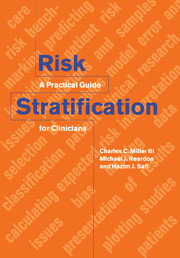6 - Advanced issues
Published online by Cambridge University Press: 22 March 2010
Summary
Although risk-stratification studies or reasonable approximations to them are available in the literature for a wide variety of medical and surgical problems, it is often the case that an acceptable match for a particular problem cannot be found. In this circumstance, the investigator is left with little choice but to compute risk estimates from his or her own data from the ground up. Although this has the potential to be a quagmire, with exercise of reasonable caution, careful attention to assumptions and, when necessary, expert statistical assistance, doing risk-stratification studies from scratch can be both useful and enlightening. Of no small importance also is the fact that such studies can be published, so that where the literature is bereft of pertinent work, there is the potential for benefit both to the investigators and to the overall advancement of the science in that area. If no good studies meeting the criteria we described in Chapter 3 are to be found, investigators are encouraged to consider pursuing an original risk analysis. In contrast with the calculator- or spreadsheet-level computations we have done thus far, a good quality statistical software package is essential for the actual construction of risk models. Our personal favorite is SAS, the Statistical Analysis System, but others are available. All of the examples that follow are from SAS programs. The major programs are similar in their approaches to these problems.
Types of studies
As we mentioned in Chapter 3, where we described the evaluation of published studies, the first thing to be determined during the contemplation of any original research is the study question.
- Type
- Chapter
- Information
- Risk StratificationA Practical Guide for Clinicians, pp. 110 - 163Publisher: Cambridge University PressPrint publication year: 2001



